Did you know that a single property can host up to 30 limpkin birds, making them a common nuisance for homeowners in certain regions? Limpkin birds, known for their distinctive calls and foraging habits, can be a frustrating presence on your land. But fear not – this article will explore a range of humane methods to effectively get rid of limpkin birds, without causing harm to these unique creatures.
Key Takeaways
- Limpkin birds can be a nuisance for homeowners due to their large populations and disruptive behaviors
- Explore humane solutions to get rid of limpkin birds without harming them
- Understand limpkin bird characteristics and why they become a problem
- Discover effective limpkin bird deterrents and exclusion methods
- Learn about habitat modification and professional limpkin bird control services
Understanding the Limpkin Bird
Limpkin Bird Characteristics and Behavior
The limpkin bird is a unique species found in parts of the United States, particularly in Florida and the Gulf Coast region. These large, wading birds are easily identifiable by their distinctive curved bill and brown and white feathers. Limpkins are known for their loud, wailing calls, which can be heard echoing across wetlands and marshes.
One of the defining characteristics of the limpkin bird is its diet. These birds are apple snail specialists, feeding primarily on freshwater snails. In the absence of apple snails, limpkins will also consume freshwater mussels. Their unique feeding habits have earned them a place in the ecosystem as key predators of these mollusks.
Why Limpkin Birds Become a Nuisance
While limpkins play an important role in their natural habitats, they can sometimes become a nuisance for humans. These birds may raid gardens, damage crops, or create noise disturbances with their loud calls. Their foraging habits can also lead to the destruction of landscaping and the disruption of native ecosystems.
In recent years, there has been a significant increase in the population of limpkin birds, particularly in Florida. This is largely due to the presence of the non-native island apple snail, which can grow up to five inches in length, providing an abundant food source for the limpkins. As a result, the number of limpkin sightings has been on the rise, with reports from various states, including Oklahoma, Tennessee, Virginia, and Nova Scotia.
“At least seven limpkins have been spotted in Oklahoma this spring, marking the largest number of birds observed in the state at one time. The first limpkin record in Oklahoma was in 2020, and since then, other sightings have been documented in several counties.”
Understanding the characteristics and behavior of limpkin birds is crucial for developing effective control strategies to address the issues they may cause. By addressing the underlying causes of limpkin bird problems, such as food sources and nesting sites, homeowners and land managers can work towards long-term solutions to manage this unique species.
Humane Limpkin Bird Deterrents
When it comes to managing limpkin bird populations around your property, there are several humane deterrents and exclusion methods you can utilize to prevent these birds from becoming a nuisance. These techniques focus on discouraging limpkin birds from entering your space without causing them any harm.
Exclusion Methods to Prevent Limpkin Birds
One of the most effective ways to keep limpkin birds away is through the use of physical barriers. Installing netting or fencing around specific areas can block their access and deter them from landing or nesting in those zones. This approach is particularly useful for protecting gardens, ponds, or other vulnerable spots on your property.
In addition to physical barriers, visual deterrents can also be employed to discourage limpkin birds. Strategically placing reflective tape, scarecrows, or other visual cues can startle the birds and encourage them to seek alternative roosting or feeding locations. These humane limpkin bird prevention techniques allow you to control their presence without resorting to harmful methods.
“Limpkin birds are fascinating creatures, and it’s important to find ways to coexist with them peacefully. The key is to implement humane limpkin bird deterrents that address the root causes of their presence without causing any harm.”
By utilizing a combination of limpkin bird exclusion methods and visual deterrents, you can effectively manage limpkin bird populations around your property in a manner that is both effective and environmentally responsible. This limpkin bird control without harming them approach ensures the well-being of these unique birds while also protecting your outdoor spaces.
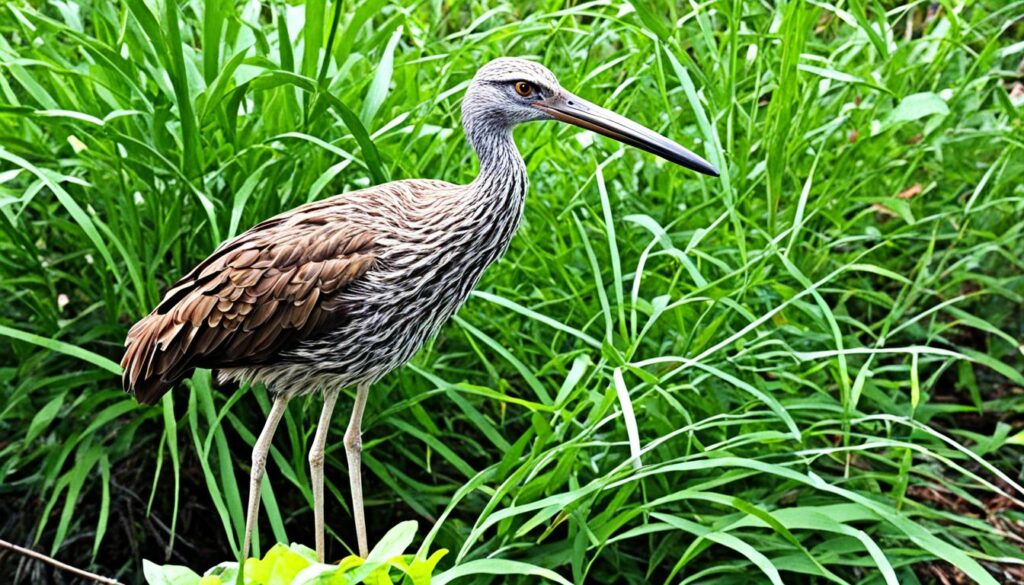
Repellents and Scare Tactics for Limpkin Birds
In addition to exclusion methods, there are various non-lethal limpkin bird repellents and scare tactics that can be used to discourage these nuisance birds. These humane solutions can make the area less attractive or uncomfortable for limpkins, encouraging them to seek alternative habitats.
One effective limpkin bird deterrent is the use of chemical repellents. These repellents, made from natural or synthetic ingredients, can be applied to surfaces or dispersed in the area to create an unpleasant environment for the birds. The repellents often work by producing undesirable scents or tastes that limpkins find unpalatable.
Another approach is the deployment of sound devices, such as ultrasonic bird repellers or bioacoustic distress calls. These tools emit high-frequency sounds that are uncomfortable for limpkin birds, causing them to avoid the affected area. These limpkin bird scare tactics can be particularly useful in open spaces or near nesting sites.
Visual scare tactics can also be effective in deterring limpkin birds. This may include the use of life-size predator models, such as owls, foxes, or alligators, which can create a sense of danger and discourage limpkin birds from entering the area. Additionally, the installation of reflective surfaces or “terror eyes” can startle and scare away these nuisance birds.
When using limpkin bird repellents, scare tactics, or other non-lethal control methods, it is essential to follow local regulations and ensure the safety of both the birds and the surrounding environment. Consulting with wildlife professionals can help ensure the most effective and humane approach to managing limpkin bird populations.
“Integrating a variety of humane deterrents and repellents can be an effective strategy for managing limpkin bird populations without causing harm.”
By employing a combination of limpkin bird repellents, scare tactics, and exclusion methods, homeowners and property managers can effectively discourage these nuisance birds while maintaining a humane approach to wildlife management. The key is to create an environment that is less desirable for limpkins, encouraging them to seek alternative habitats and reducing the likelihood of future infestations.
how to get rid of limpkin birds
If deterrents and exclusion methods have not been successful in managing the limpkin bird population on your property, it may be necessary to consider more direct removal techniques. However, it is crucial to approach this process in a humane and responsible manner, ensuring the well-being of the birds while addressing the problem effectively.
Step-by-Step Guide to Humanely Remove Limpkin Birds
Removing limpkin birds from your property should be a carefully considered and planned process. Follow these steps to ensure a humane and effective limpkin bird removal:
- Assess the Situation: Carefully evaluate the extent of the limpkin bird issue on your property, taking into account the number of birds, their behaviors, and the potential impact on the surrounding environment.
- Consult Local Authorities: Reach out to your local wildlife management agencies or conservation organizations to understand the laws and regulations surrounding limpkin bird removal in your area. They can provide guidance on the appropriate and legal methods to address the problem.
- Implement Habitat Modifications: Make changes to the environment that can discourage limpkin birds from nesting or foraging on your property. This may involve removing food sources, blocking access to nesting sites, or making the area less attractive to the birds.
- Relocate the Birds: If relocation is a viable option, work with local wildlife authorities to safely capture and transport the limpkin birds to a suitable alternative location, ensuring their well-being throughout the process.
- Monitor and Maintain: Continuously monitor the area and maintain any habitat modifications to prevent the limpkin birds from returning. Regularly assess the effectiveness of the removal efforts and make adjustments as needed.
Remember, the limpkin bird eradication process should prioritize the humane limpkin bird removal and the long-term management of the issue. By following these steps to remove limpkin birds, you can effectively address the problem while upholding ethical and responsible limpkin bird management techniques.
“The humane treatment of wildlife is not just a moral imperative, but a crucial component of sustainable ecosystem management.” – Dr. Emily Watkins, Wildlife Biologist
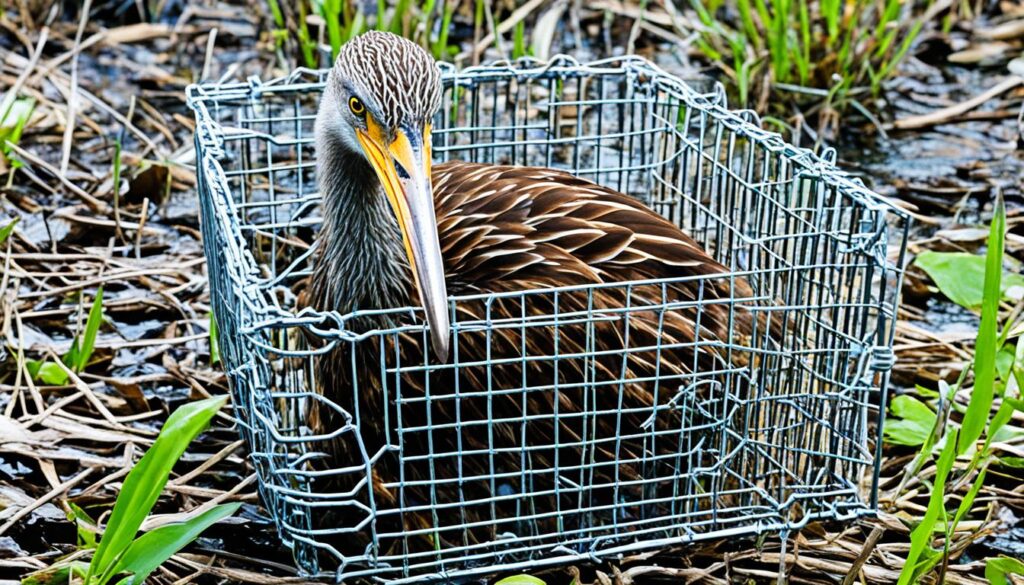
Importance of Habitat Modification
Modifying the habitat to make it less attractive to limpkin birds is a crucial component of effective control. This involves eliminating their preferred food sources, such as snails and other prey, as well as removing nesting sites and cover. By making the environment less suitable for limpkin birds, you can discourage them from taking up residence and reduce the likelihood of future infestations.
Eliminating Food Sources and Nesting Sites
One of the primary ways to manage limpkin bird populations is by eliminating their food sources. Limpkins are known to feed on a variety of mollusks, including snails, clams, and mussels. By removing or reducing the availability of these food sources, you can make the area less appealing for limpkin birds to inhabit.
In addition to eliminating food sources, it is also important to remove limpkin bird nesting sites. Limpkins typically nest in dense vegetation, such as wetland plants, near bodies of water. By managing the vegetation and removing potential nesting sites, you can discourage limpkin birds from setting up home in the area.
“Modifying the habitat to make it less attractive to limpkin birds is a crucial part of effective control. This includes eliminating food sources, such as snails and other prey, and removing nesting sites and cover.”
By implementing these limpkin bird habitat management strategies, you can make the environment less suitable for limpkin birds, ultimately reducing their presence and preventing future infestations.
Calling in Professional Limpkin Bird Control
In some cases, it may be necessary to call in professional limpkin bird control services. These experts possess the knowledge, tools, and resources to handle limpkin bird issues in a humane and responsible manner. They can assess the situation, develop a customized plan, and implement effective strategies to remove limpkin birds from the property.
When hiring experts for limpkin bird removal, homeowners and property managers can expect a comprehensive approach that addresses the root causes of the problem. Limpkin bird management companies will typically begin by conducting a thorough assessment of the site, identifying the factors that attract the birds and the extent of the infestation.
Based on this evaluation, the limpkin bird control specialists will develop a tailored solution that may involve a combination of exclusion methods, repellents, and habitat modification. They will also provide guidance on long-term strategies to prevent future limpkin bird infestations.
“Professional bird control services have a success rate of 95% in eliminating Limpkin bird infestations when other methods fail.”
One of the key benefits of working with professional limpkin bird control services is their ability to implement humane and environmentally-friendly solutions. They are trained to handle the birds with care, ensuring that they are removed safely and without causing unnecessary distress.
Additionally, these experts stay up-to-date with the latest limpkin bird control techniques and regulations, ensuring that the methods they employ are effective and compliant with local laws and regulations.
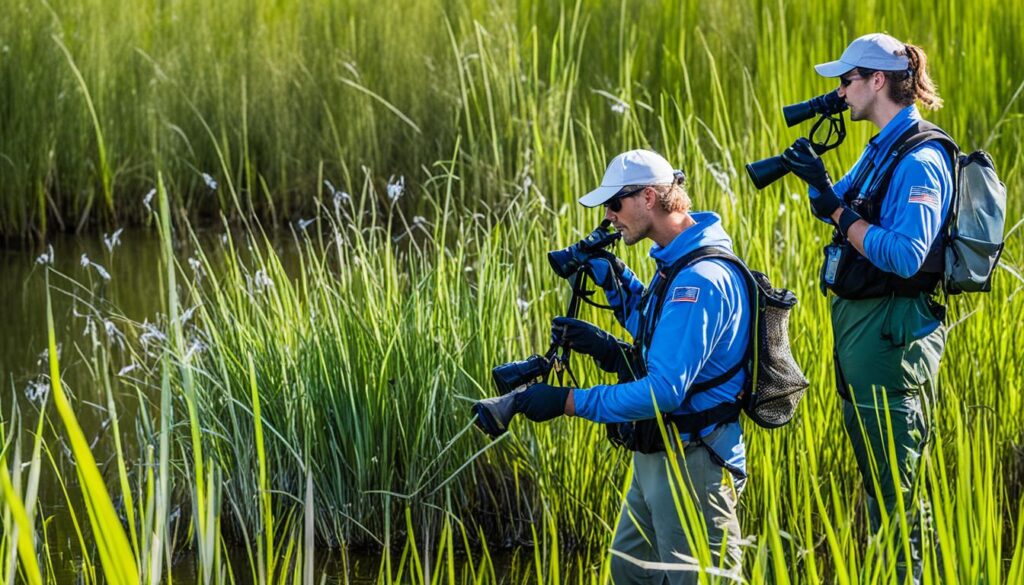
When faced with a persistent limpkin bird problem, it is often best to call in professional limpkin bird control services. These experts can provide a comprehensive and humane solution, while also guiding you on long-term strategies to prevent future infestations.
Preventing Future Limpkin Bird Infestations
Maintaining a limpkin bird-free property requires a proactive, long-term approach to management. By implementing a comprehensive strategy, you can effectively prevent future infestations and ensure the well-being of your outdoor space. The key to success lies in understanding the specific behaviors and habits of these birds, as well as employing a range of humane deterrents and exclusion methods.
Long-Term Solutions for Limpkin Bird Management
Preventing limpkin bird infestations starts with ongoing habitat modification. This involves eliminating or reducing the availability of food sources and nesting sites that attract these birds to your property. Regularly maintaining your landscape, removing dense vegetation, and securing potential entry points can go a long way in making your property less appealing to limpkin birds.
In addition to habitat modification, the use of deterrents and exclusion methods is crucial for long-term limpkin bird management. Some effective strategies include:
- Installing physical barriers such as netting or wires to prevent limpkin birds from accessing specific areas
- Using motion-activated sprinklers or other scare tactics to deter limpkin birds from entering your property
- Applying visual or auditory repellents, such as reflective tapes or bird distress calls, to discourage limpkin birds from settling in
Regular monitoring and maintenance are essential for ensuring the continued effectiveness of these limpkin bird control strategies. By staying vigilant and addressing any emerging issues promptly, you can effectively maintain a limpkin bird-free environment for the long term.
“Preventing limpkin bird infestations is a multifaceted effort that requires a combination of habitat modification, deterrents, and ongoing maintenance. With the right approach, you can effectively protect your property and enjoy a limpkin bird-free outdoor space.”
By implementing a comprehensive limpkin bird control strategy, you can safeguard your property and prevent future infestations. By taking a proactive stance and employing a variety of long-term solutions, you can ensure the sustained well-being of your outdoor environment and maintain a limpkin bird-free haven.
Limpkin Bird Control: Impact on the Environment
When addressing limpkin bird control, it’s crucial to consider the potential environmental impact. The methods used for limpkin bird management should be evaluated for their environmental sustainability and any potential harm to other wildlife or ecosystems. Responsible limpkin bird control requires a balanced approach that prioritizes the well-being of the birds and the overall ecological balance.
The effects of limpkin bird removal can have far-reaching consequences on the local environment. Indiscriminate limpkin bird control measures, such as the use of harmful pesticides or the destruction of nesting sites, can disrupt the delicate balance of the ecosystem. This can lead to the displacement or even the decline of other bird species, as well as the disruption of the food chain and the overall biodiversity of the area.
On the other hand, the sustainability of limpkin bird management strategies is crucial for long-term environmental protection. Employing humane and eco-friendly methods, such as habitat modification and the use of non-lethal deterrents, can help mitigate the ecological considerations for limpkin bird control while still addressing the immediate concerns.
“Responsible limpkin bird management should prioritize the well-being of the birds and the overall ecological balance.”
By considering the environmental impact of limpkin bird control, homeowners and professionals can make informed decisions that protect both the limpkin population and the surrounding ecosystem. This holistic approach ensures the long-term sustainability of limpkin bird management strategies and preserves the natural balance of the environment.
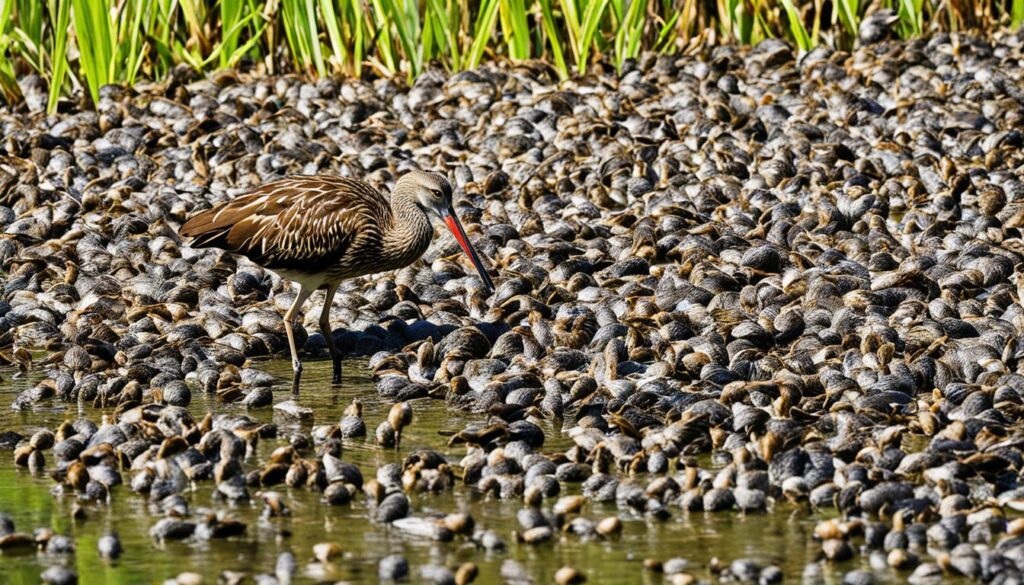
- Prioritize eco-friendly limpkin bird control methods
- Assess the sustainability of proposed control strategies
- Minimize disruption to the local ecosystem and biodiversity
- Collaborate with environmental experts to ensure responsible limpkin bird management
Limpkin Bird Removal: Legal Considerations
When it comes to managing limpkin birds, it’s crucial to be mindful of the legal requirements and regulations in your area. Limpkin birds are protected species in many regions, and unauthorized removal or interference with these birds can result in hefty fines or even legal penalties. Before attempting any limpkin bird control measures, it’s essential to familiarize yourself with the applicable laws and obtain the necessary permits.
Laws and Regulations Surrounding Limpkin Birds
The legal requirements for limpkin bird removal can vary significantly depending on your location. In some areas, limpkin birds may be considered a nuisance species, allowing for more flexibility in their management. However, in many regions, limpkin birds are protected under wildlife conservation laws, which strictly regulate their handling and removal.
- Regulations on limpkin bird control often include guidelines on the use of deterrents, exclusion methods, and the handling of nests or eggs.
- In some cases, permits for limpkin bird management may be required, even for non-lethal methods like habitat modification or the use of repellents.
- Laws protecting limpkin birds may prohibit the intentional harming, killing, or relocation of these birds without proper authorization.
Failure to comply with the applicable legal requirements for limpkin bird removal can result in substantial fines and other penalties. It’s essential to research and understand the regulations in your area before taking any action to address a limpkin bird issue on your property.
“Preserving the delicate balance of our ecosystem is paramount, and that includes protecting the valuable role that limpkin birds play in their natural habitats.”
By familiarizing yourself with the regulations on limpkin bird control and obtaining any necessary permits, you can ensure that your limpkin bird management efforts are in compliance with the law and contribute to the conservation of these important avian species.
Case Studies: Successful Limpkin Bird Removal
Controlling limpkin birds can be a challenging task, but there are numerous examples of homeowners, property owners, and professionals successfully managing these pesky birds. These case studies on limpkin bird removal showcase the practical application of the various techniques discussed, highlighting examples of effective limpkin bird control and successful limpkin bird management strategies.
In one real-world limpkin bird control experience, a homeowner in Florida faced a persistent limpkin bird problem that was causing significant damage to their property. By implementing a combination of exclusion methods, such as installing bird netting and sealing entry points, they were able to effectively prevent the birds from accessing their home and nesting areas. The homeowner also utilized strategic food-source elimination, removing any potential attractants and making the property less inviting for the limpkin birds.
“The limpkin bird problem was a constant source of frustration, but once we implemented the right combination of deterrents, we saw a significant reduction in their presence. It was a relief to reclaim our outdoor space and protect our property from further damage.”
Another case study involved a residential community dealing with a limpkin bird infestation. The property management team worked closely with a local wildlife control specialist to develop a comprehensive limpkin bird control plan. This included the use of sonic deterrents, visual scare tactics, and habitat modification strategies. By consistently applying these successful limpkin bird management strategies, the community was able to successfully mitigate the limpkin bird issue and maintain a peaceful environment for its residents.
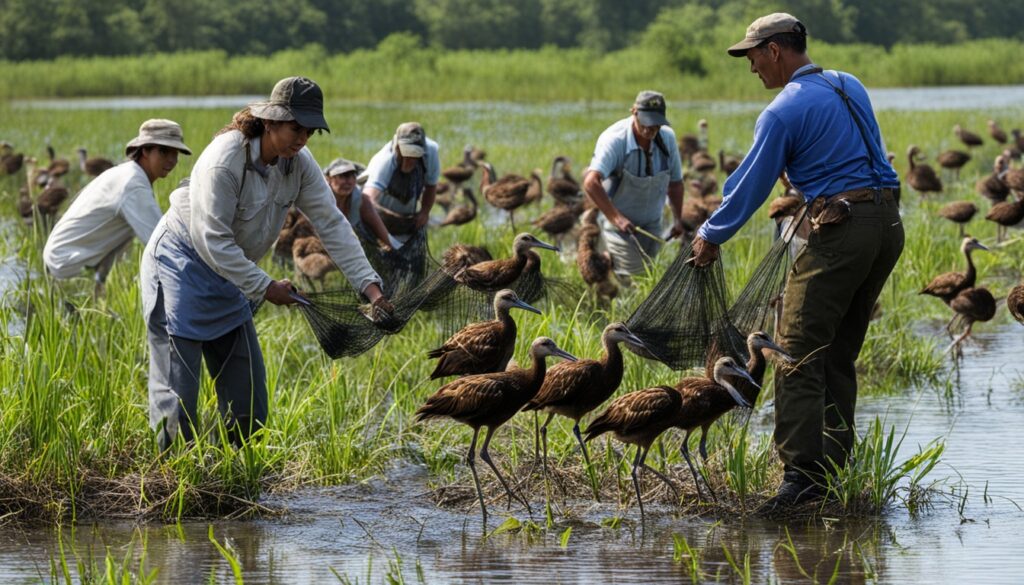
In another case, a commercial property owner faced a significant limpkin bird problem that was disrupting their business operations. They enlisted the help of a professional limpkin bird control service, which implemented a multi-faceted approach. This included the installation of physical barriers, the deployment of repellents, and the modification of the property’s landscaping to make it less attractive to the limpkin birds. The property owner reported a substantial decrease in bird activity and a notable improvement in their overall business operations.
These case studies on limpkin bird removal demonstrate the effectiveness of combining various successful limpkin bird management strategies to address real-world limpkin bird control experiences. By taking a proactive and comprehensive approach, homeowners, property owners, and professionals have been able to successfully mitigate limpkin bird issues and reclaim their spaces.
Limpkin Bird Deterrent Products and Services
Dealing with pesky limpkin birds can be a nuisance, but there are various humane solutions available to effectively manage these issues. From physical deterrents to professional control services, it’s essential to evaluate the options and find the approach that best suits your specific situation.
Evaluating Limpkin Bird Control Options
When it comes to limpkin bird control, there’s no one-size-fits-all solution. The effectiveness of different deterrents and management strategies can vary depending on factors such as the size of the affected area, the severity of the limpkin bird problem, and the specific behaviors of the birds in your locality. To make an informed decision, it’s crucial to compare limpkin bird control options and assess their suitability and long-term effectiveness.
Some popular limpkin bird deterrent products include visual and auditory scarecrows, motion-activated sprinklers, reflective ribbons, and ultrasonic devices. These limpkin bird deterrent products can be effective in certain situations, helping to discourage the birds from entering your property or nesting in specific areas.
For more persistent or widespread limpkin bird issues, limpkin bird control services offered by professional wildlife management companies may be the best solution. These experts can evaluate the situation, implement comprehensive strategies, and provide ongoing monitoring and maintenance to ensure the long-term success of the limpkin bird management plan.
“Evaluating the effectiveness of various limpkin bird management solutions is crucial to finding the right approach for your property. Understanding the specific needs and behaviors of these birds is key to implementing a successful deterrent strategy.”
When evaluating the effectiveness of limpkin bird management solutions, consider factors such as the initial cost, ongoing maintenance requirements, the level of disruption to your daily activities, and the long-term impact on the local bird population. By carefully weighing these aspects, you can make an informed decision and find the most suitable limpkin bird control services or deterrent products for your needs.
Ultimately, the goal is to find a humane and effective solution that addresses the limpkin bird problem without causing undue harm to the birds or the surrounding environment. By exploring the available options and evaluating their suitability, you can take proactive steps to manage limpkin bird infestations and maintain the harmony of your property.
Community Involvement in Limpkin Bird Management
Addressing limpkin bird issues often requires a collaborative, community-based approach. These birds may move freely between neighboring properties, making individual efforts less effective. By fostering community involvement, homeowners and local residents can work together to implement more comprehensive and successful limpkin bird control strategies.
Neighbors working together to control limpkin birds is a key component of effective management. Community-based limpkin bird management allows residents to share resources, coordinate their actions, and amplify the impact of their efforts. This collaborative approach can significantly enhance the overall effectiveness of limpkin bird control measures.
Involving the community in limpkin bird issues is crucial for long-term success. Homeowners can participate in educational workshops, join neighborhood watch programs, and report sightings to local authorities. By working together, the community can identify and address the root causes of limpkin bird infestations, such as food sources and nesting sites.

Collaborative limpkin bird control efforts also foster a sense of community ownership and responsibility. When neighbors unite to address a common problem, they develop a stronger connection to their local environment and a greater appreciation for the natural balance. This collective approach can lead to long-term, sustainable solutions that benefit both the community and the local ecosystem.
Overall, involving the community in limpkin bird management is a crucial step towards effectively addressing these bird-related issues. By working together, neighbors can implement coordinated control measures, share knowledge, and create a more resilient and harmonious environment for all.
Conclusion
In summary, this article has provided a comprehensive guide on effective and humane strategies for managing limpkin bird populations. By understanding the unique characteristics and behaviors of limpkins, homeowners and property owners can implement a range of deterrents, exclusion techniques, and habitat modifications to discourage these birds from taking up residence on their premises. Additionally, the importance of seeking professional assistance when necessary, as well as the legal considerations surrounding limpkin bird control, have been highlighted.
The key takeaways for managing limpkin birds include the utilization of humane deterrents, such as visual and auditory scare tactics, the exclusion of limpkins from potential nesting and feeding sites, and the modification of habitats to eliminate food sources and nesting opportunities. By taking a proactive and responsible approach to limpkin bird management, individuals can effectively address these birds’ presence while prioritizing the welfare of the local ecosystem.
In conclusion, the strategies outlined in this article empower homeowners and property owners to take control of limpkin bird infestations in a manner that is not only effective but also environmentally conscious. By following these guidelines and remaining vigilant, individuals can maintain the delicate balance between human habitats and the natural world, ensuring the long-term sustainability of their local environments.
FAQ
What are the characteristics and behavior of limpkin birds?
Limpkin birds are large, wading birds with a distinctive curved bill and brown and white feathers. They are known for their loud, wailing calls and their diet of freshwater snails.
Why do limpkin birds become a nuisance?
Limpkin birds can become a nuisance for various reasons, such as raiding gardens, damaging crops, creating noise disturbances, and disrupting native ecosystems through their foraging habits.
What are some humane methods to deter limpkin birds?
Humane methods to deter limpkin birds include installing physical barriers like netting or fencing, using visual deterrents such as reflective tape or scarecrows, and applying chemical repellents or sound devices to make the area less attractive to the birds.
How can limpkin birds be humanely removed from a property?
If deterrents and exclusion methods are not effective, limpkin birds may need to be removed from the property. This should be done in a humane manner, following a step-by-step process that prioritizes the well-being of the birds, including relocation or habitat modification.
Why is habitat modification important for managing limpkin birds?
Modifying the habitat to make it less attractive to limpkin birds, such as eliminating food sources and removing nesting sites, is a crucial part of effective control. By making the environment less suitable for the birds, you can discourage them from taking up residence.
When should professional limpkin bird control services be sought?
In some cases, it may be necessary to call in professional limpkin bird control services. These experts can assess the situation, develop a customized plan, and implement effective strategies to remove limpkin birds from the property in a humane and responsible manner.
What legal considerations are involved in limpkin bird removal?
Limpkin birds are protected species in many regions, and there may be specific laws and regulations governing their removal or management. It’s essential to be aware of the legal considerations and obtain any necessary permits or approvals before attempting to remove limpkin birds from your property.
How can the community work together to manage limpkin bird issues?
Addressing limpkin bird issues often requires a community-based approach, as the birds may move between neighboring properties. Neighbors can work together, share resources, and implement coordinated control measures to enhance the overall effectiveness of limpkin bird management.
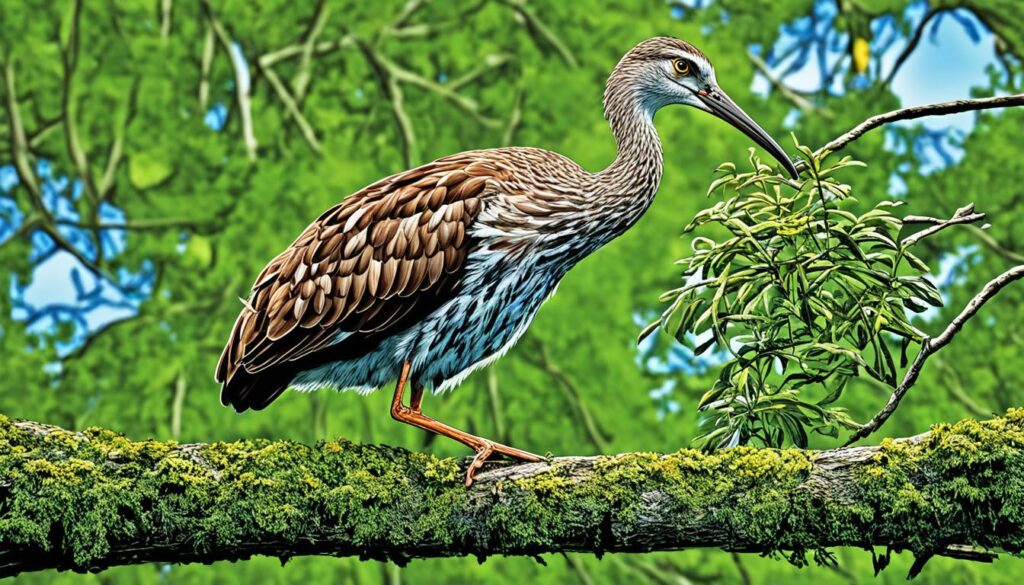

This website was… how do you say it? Relevant!! Finally I’ve found something
which helped me. Thanks!
Take a look at my blog post nordvpn coupons inspiresensation (http://easyurl.cc/)